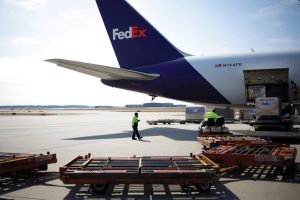BLOOMBERG
FedEx Corp reported profit below analyst expectations as cost cuts weren’t enough to make up for volume declines at the air-freight unit amid a lingering cargo recession. The company lowered its sales forecast for the fiscal year ending on May 31.
Adjusted earnings were $3.99 a share, the Memphis, Tennessee-based company said in a statement. Analysts had expected $4.19. Sales fell 2.6% to $22.2 billion.
Analysts had predicted $22.4 billion.
FedEx Express, the air-freight unit, is still struggling from overcapacity as commercial airliners resume international flights and from sluggish demand in Asia. FedEx’s freight unit, one of the largest US trucking companies, has been hurt by a drop in cargo demand and price. That weakness was offset a bit by cargo that carriers picked up from Yellow Corp, which ceased operations earlier this year.
“The miss was driven solely by Express,” said Christian Wetherbee, an analyst with Citigroup in a note. “Ground and Freight profit both beat.”
This year’s peak shipping season has been muted as consumers return to stores and contend with inflation and higher interest rates, denting buying power.
Nonetheless, FedEx’s Ground unit posted gains on volume and price per package, helped by customers who made the switch from United Parcel Service Inc.
The soft market enabled FedEx to improve its on-time delivery performance, which may make it more difficult for UPS to win back lost customers, Garrett Holland, an analyst with Robert W Baird & Co wrote in a note. Both UPS and FedEx delivered about 98% of packages on time in the week after Thanksgiving, according to ShipMatrix, a consultancy that gathers industry data.
Shares fell 10% in US postmarket trading to $252.06 in New York, which would be the biggest decrease since September 16, 2022. FedEx’s adjusted operating margin rose to 6.4% from 5.3% a year earlier, spurred by permanent cost reductions that are expected to reach $1.8 billion for the fiscal year, FedEx said.
FedEx is powering through the trough in freight demand with a long-term $6 billion cost-cutting and efficiency plan implemented shortly after Raj Subramaniam took over as chief executive officer from founder Fred Smith in June last year. The cost reductions are already bearing fruit, underpinning a 62% gain in FedEx’s stock price this year.
The company lowered its sales forecast to a “low-single-digit percentage decline” from an earlier forecast of little changed. The company left unchanged its forecast of adjusted profit of $17 to $18.50 a share.
Ground units sales rose 2.9% to $8.6 billion and operating margins rose to 10.4% from 7.1% a year earlier on higher volume and revenue per package, showing that the courier still has pricing power even as the market cools from the pandemic highs. Cost per package declined 2%, FedEx said.
The Express unit’s sales fell 5.6% on lower volume and a shift toward lower-yielding services. Adjusted operating margins tumbled to 1.3% from 3.1% a year earlier. At the Freight unit, sales dropped 3.8% while operating margins rose to nearly 21% from 18%.
Subramaniam announced a restructuring of the Express unit by dividing up uses of its aircraft into three categories that it designated as purple, orange and white. While the Express unit is taking market share from competitors now, the industry is declining, which has put pressure on margins, he said on a conference call with analysts.
“I’m very confident the margins at Express will return and the cost take-out that’s continuing to take place will serve us very well especially as the demand profile returns,” Subramaniam said.
 The Gulf Time Newspaper One of the finest business newspapers in the UAE brought to you by our professional writers and editors.
The Gulf Time Newspaper One of the finest business newspapers in the UAE brought to you by our professional writers and editors.
